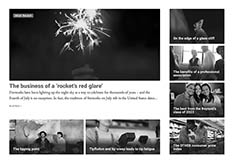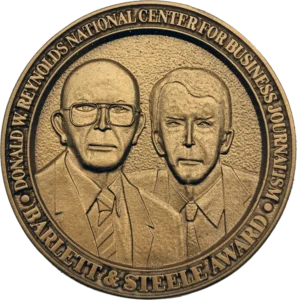The inverted pyramid might be the classic model for structuring a news story, but it doesn’t work very well for business and financial news – where the news often focuses on what changed from a year (or a quarter) ago and whether that change met expectations (or not).
For example, if you’re covering the announcement of U.S. gross domestic product data – the key measurement of economic performance – the news isn’t the overall size of the economy but rather how that size changed from the previous data. That’s why you’ll almost never see the actual GDP figure in a headline; instead you’ll see the percentage change from the previous quarter or year. As for why that change happened, the best technique (besides interviewing experts) is to drill down below that headline number to see how individual components of GDP fared.
The same technique can be used to explain why a benchmark stock index, like the S&P 500, was up or down, or to measure a company’s performance. What matters more than the actual amount of net profit a company reports is how that figure compares with the profit generated in the same period a year earlier. Looking into a company’s profit-and-loss statement will provide clues as to the cause of that change.
Because the “change” and the “cause” of that change are almost always the key newsworthy elements in a financial news story, these two Cs are almost always in the first sentence. It is then followed by Expectations, Context, Comment, and Future.
CCE-CCF
“Expectations” are the driving force behind market prices – you’d only buy shares in Apple, for example, if you expected the company’s performance would get better in the future. Expectations are also a key part of any good business news story and should come soon after the first two Cs. As people’s expectations for the future are baked into asset prices, any event that confounds those expectations (either on the positive side or negative) will lead to a change in prices.
While it’s impossible to get a detailed view of everyone’s individual expectations, it’s possible to estimate an average by surveying experts. Many financial news organizations, such as Bloomberg and Reuters, conduct their own polling of expectations ahead of major corporate or economic events.
Every news story needs a paragraph on the significance or context of the news and business news is no different. Each business story should explain why the news matters to the reader. This “context” element should come at the top, right after “expectations.”
Next, business news stories rely on “comment” from experts to help readers understand the news and its significance. These quotes, if chosen well, can often reinforce the “context” section of the news story, or highlight key elements of the news.
Finally, if there’s a scheduled “future” event that might alter “expectations,” such as the release of a related economic indicator or a rival company’s profit announcement, it’s good practice to also note that after all the other story elements are in place.
So if you need a mnemonic to remember the key components of a business news story, think CCE – CCF:
Change
Cause
Expectations
Context
Comment
Future







